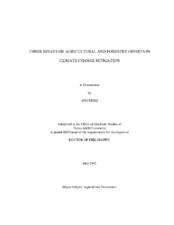| dc.contributor.advisor | Woodward, Richard T. | |
| dc.creator | Feng, Siyi | |
| dc.date.accessioned | 2012-07-16T15:58:37Z | |
| dc.date.accessioned | 2012-07-16T20:25:11Z | |
| dc.date.available | 2012-07-16T15:58:37Z | |
| dc.date.available | 2012-07-16T20:25:11Z | |
| dc.date.created | 2012-05 | |
| dc.date.issued | 2012-07-16 | |
| dc.date.submitted | May 2012 | |
| dc.identifier.uri | https://hdl.handle.net/1969.1/ETD-TAMU-2012-05-11121 | |
| dc.description.abstract | This dissertation is composed of three essays, investigating two aspects of the role of agricultural sector in climate change mitigation: leakage and additionality.
Leakage happens when mitigation policies reduce net GHG emissions in one context, but increase (decrease) prices, which in turn causes production (demand) expansion resulting in an offsetting rise in emissions elsewhere. The first essay documents an integration of a US domestic agricultural sectoral model and a global agricultural sectoral model, with the aim to deliver better leakage assessment. The second essay investigates the trend of US crop yield growth and its implication on the international leakage effect. We find that the slowdowns have occurred to the growth rates of most US major crops. The implementation of climate change mitigation strategies, such as the expansion of bioenergy production, causes demand for the agricultural sector to increase substantially. The new demand would cause noticeable leakage effect if crop yields continue to grow at the current rates. Such effect may be potentially alleviated by higher crop yield growth rates; but the extent of alleviation depends on the mix of technological progress obtained across crops as well.
Additionality is often a concern in programs designed to incentivize the production of environmental services. Additionality is satisfied if payments are made to services that would not have occurred without the payment. However, because of the information asymmetry between service buyers and sellers, ensuring additionality poses a challenge to program designers. The third essay investigates how the pursuit of ensuring additionality would complicate environmental policy design with a theoretical model. Specifically, we examine 4 types of policy design, including 2 discriminating schemes and 2 simpler non-discriminating schemes. We found that under certain conditions, some of the non-discriminating schemes can be almost as good as the discriminating ones.
Findings in this dissertation contribute to inform policy makers about the potential impacts of climate change mitigation policies in the agricultural sector and also help to improve understanding of environmental program design. | en |
| dc.format.mimetype | application/pdf | |
| dc.language.iso | en_US | |
| dc.subject | Climate Change Mitigation | en |
| dc.subject | Leakage | en |
| dc.subject | Additionality | en |
| dc.subject | Payment for Environmental Service | en |
| dc.title | Three Essays On Agricultural and Forestry Offsets In Climate Change Mitigation | en |
| dc.type | Thesis | en |
| thesis.degree.department | Agricultural Economics | en |
| thesis.degree.discipline | Agricultural Economics | en |
| thesis.degree.grantor | Texas A&M University | en |
| thesis.degree.name | Doctor of Philosophy | en |
| thesis.degree.level | Doctoral | en |
| dc.contributor.committeeMember | McCarl, Bruce A. | |
| dc.contributor.committeeMember | Newburn, David A. | |
| dc.contributor.committeeMember | Puller, Steven L. | |
| dc.type.genre | thesis | en |
| dc.type.material | text | en |


